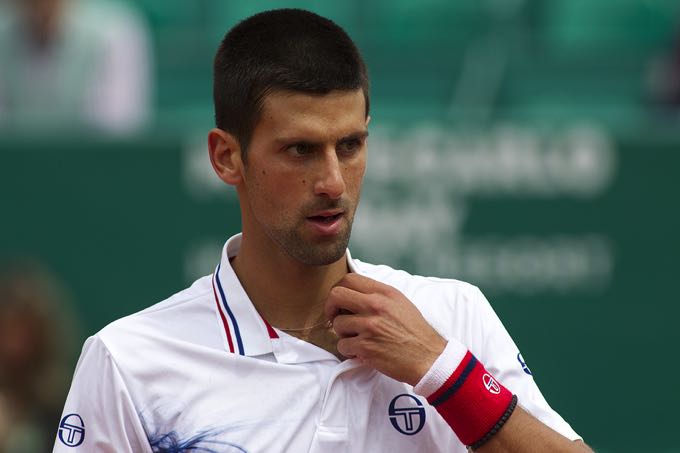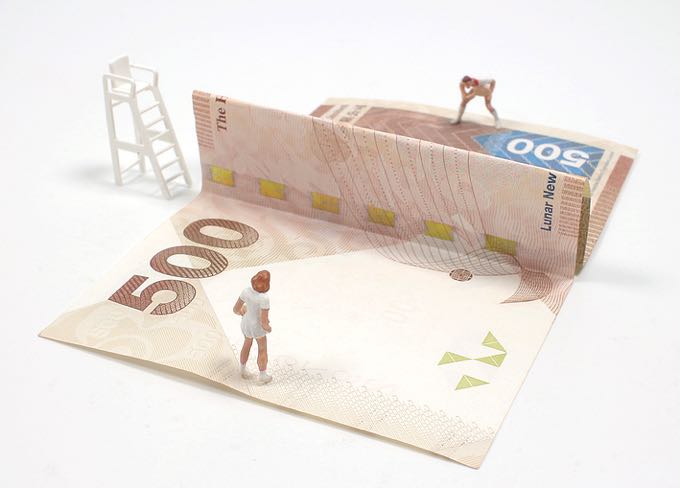 If you were to follow tennis tournaments from the point of view of watching Wimbledon, you might well imagine that it is a game reserved for gentlemen and ladies. Certainly that is the image that the sport likes to project, but that doesn’t mean that those involved don’t stray beyond the boundaries of what a gentleman or a lady might do. It is far from unheard of for a player to be disqualified from a tournament for unsporting conduct, for example, which neither a gentleman nor a lady in the traditional sense would ever be guilty of.
If you were to follow tennis tournaments from the point of view of watching Wimbledon, you might well imagine that it is a game reserved for gentlemen and ladies. Certainly that is the image that the sport likes to project, but that doesn’t mean that those involved don’t stray beyond the boundaries of what a gentleman or a lady might do. It is far from unheard of for a player to be disqualified from a tournament for unsporting conduct, for example, which neither a gentleman nor a lady in the traditional sense would ever be guilty of.
There are many other reasons why someone might be disqualified, but generally, the rule is used when someone has done something under the guidance of ‘unsporting conduct’. There have been several examples over the years, some of which have made the headlines, but they have all fit within the guidelines of the tournament in which the offence has taken place. There is a list of code violations in the Rules & Regulations of Tennis that, if broken, can result in an umpire or tournament official issuing the player responsible with a point penalty or suspension point.
Reasons Players Can Get Disqualified
The Rules & Regulations of Tennis state that players can be issued with either a point penalty or a suspension point on occasions when they violate a rule or fails to follow the tennis Code of Conduct. This is thanks to Section IV, Article C, Item 18 of the Rules, which is relating to Unsportsmanlike Conduct. At this point, it is common for the first offence to result in the player being issued with a warning, which is escalated to the loss of a point for their second offence and loss of a game for the third offence, as well as any subsequent events.
After the third offence, the chair umpire or the court official can choose to disqualify the guilty party from the tournament in question. These issues do not include any ‘off-court’ behaviour of a player, such as drug use, unsuitable attire or poor behaviour at press conferences. Here is a list of the code violations, as well as the number of times that they occurred at one of the Grand Slam tournaments between 1998 and 2018, according to the New York Times. The numbers are for the men’s and women’s competitions:
| Offence | Number of Women Fined | Number of Men Fined |
|---|---|---|
| Racket Abuse | 99 | 646 |
| Audible Obscenity | 140 | 344 |
| Unsportsmanlike Conduct | 67 | 287 |
| Coaching | 152 | 87 |
| Ball Abuse | 35 | 50 |
| Verbal Abuse | 16 | 62 |
| Visible Obscenity | 11 | 20 |
| No Press | 10 | 6 |
| Time Violations | 3 | 7 |
| Best Effort | 0 | 2 |
| Default | 0 | 3 |
| Doubles Attire | 1 | 2 |
| Late for Match | 1 | 1 |
| First Round Retirement | 0 | 2 |
| Total | 539 | 1,519 |
The most astute amongst you will be aware that 1,519 men and 539 women have not been disqualified from the Majors over the ten years in question. That is because the violations in question can result in players being given warnings, rather than immediate disqualifications from a tournament. In actual fact, 23 players or doubles teams were disqualified from a tournament for one reason or another between 1976 and 2022.
Actual Disqualifications Between 1976 & 2022

Djokovic (sportsphotographer.eu / Bigstockphoto.com)
In order to get a better sense of why players are disqualified from tournaments, it is worth having a look at the actual reasons that it has happened over the years. Interestingly, despite there being 25 occasions when it has happened, only one of them involved both players in a doubles team being given their marching orders and send home from the competition. Here is a look at each example, as well as the opponent that the disqualified person was up against and the ATP Tour or WTA Tour event in which it happened.
Ilie Năstase – 1976 Indian Wells v Roscoe Tanner
Romanian tennis player Ilie Năstase was defaulted out of his game against Roscoe Tanner for three violations, including showing his behind to the tournament referee, swearing at him and leaving the court. It was the third day in succession in which Năstase was playing and the tournament referee had to get involved.
Andrés Gómez – 1988 Cincinnati Open v Carl Limberger
The 1988, Cincinnati Open was the next time that a player was disqualified from a competition. This time it was Ecuadorian, Andrés Gómez, who was given his marching orders after he was guilty of committing two audible obscenities, hitting the court microphone and smashing his racket against the floor of the court.
John McEnroe – 1990 Australian Open v Mikael Pernfors
Tennis fans of a certain vintage will have been wondering when John McEnroe’s name was going to show up on this list, with the only surprise being that it’s only on it once. At the 1990 Australian Open, the American player was issued with three consecutive code violations, firstly for intimidating a lines woman, then for abuse his racket before being disqualified for verbally abusing the chair umpire.
Carsten Arriens – 1995 French Open v Brett Steven
Sometimes players get disqualified for deliberate acts when they should be able to show more restraint, whilst on other occasions they’re just a bit unlucky. German player Carsten Arriens would probably feel as though he fits into the latter category, having thrown his racket at his chair but seeing it strike a line judge on their leg on the way. He’d already been given a warning for throwing his racket at the net when he lost the second set.
Tim Henman & Jeremy Bates – 1995 Wimbledon v Jeff Tarango & Henrik Holm
Generally thought of as the good boy of British tennis, Tim Henman hit a tennis ball in anger after losing a point and it struck a ball girl on the ear. The umpire decided that it was a serious code violation and awarded the match to Henman and his doubles partner Jeremy Bates’ opponents, much to the anger of the watching crowd at Wimbledon.
Jeff Tarango – 1995 Wimbledon v Alexander Mronz
Having witnessed Henman get booted out of the tournament for hitting a ball girl, Jeff Tarango should have been better behaved in his match against Alexander Mronz. Instead, he told spectators to ‘shut up’, called the umpire the ‘most corrupt official in the game’ and walked off the court. Not only was he disqualified, he was also fined £28,000 and banned from Wimbledon in 1996.
Shuzo Matsuoka – 1995 US Open v Petr Korda
Was 1995 the year for poorly behaved tennis players? It is possible, given that Shuzo Matsuoka was disqualified from the US Open that year after collapsing due to severe cramping in his thighs. According to the rules at the time, he wasn’t allowed to receive medical treatment and was instead guilty of delaying play. Interestingly, the rules were changed as a result of what happened in this match.
Andre Agassi – 1996 Atlanta Open v Daniel Nestor
Andre Agassi was a brilliant tennis player, but a combustible one. Having previous received what some in the tennis world thought was ‘special treatment’ in the past, he was kicked out of the Atlanta Open after firstly ball abuse and then verbal abuse.
Irina Spîrlea – 1996 Palermo Ladies Open v Stephanie Devillé
The first female to be disqualified from a tournament saw her fate sealed when she directed abusive language at an official.
Mariano Zabaleta – 1997 Miami Open v Adrian Voinea
As with other players that we’ve already mentioned, Mariano Zabaleta was somewhat unlucky during his match against Adrian Voinea during the Miami Open in 1997. Frustrated with his performance, he hit a ball in anger and it struck a line judge, leading to his disqualification.
Stefan Koubek – 2000 French Open v Attila Sávolt
Another misfortune occurred to Stefan Koubek during the French Open in 2000. When playing Attila Sávolt, he struck a ball boy with a tennis ball and was disqualified as a result.
Marcelo Rios – 2000 Los Angeles Open v Gouichi Motomura
Whilst some examples on this list could be put down to misfortune, the same can’t be said for the behaviour of Marcelo Rios in 2000. The Chilean player was the world number 1 at one point, but had a day to forget during his match with Gouichi Motomura in the Los Angeles Open. He swore at the umpire, resulting in his disqualification and a fine of $5,000 being issued.
Xavier Malisse – 2005 Miami Open v David Ferrer
Belgian player Xavier Malisse was beating David Ferrer when a line judge foot-faulted him twice. He threw a ball at her, verbally abused an official, smashed his racked and kicked over his chair, seeing him given his marching orders for ‘aggravated behaviour’. He also had to return his prize money, pay a fine and endure a four-week suspension.
Stefan Koubek – 2007 Open de Moselle v Sébastien Grosjean
Having not learnt his lesson in 2000, Stefan Koubek suffered another disqualification seven years later for directing abusive language towards the tournament supervisor. It occurred during a disputed line call, showing the need to maintain calm at all times.
Anastasia Rodionova – 2007 Cincinnati Masters v Angelique Kerber
When spectators cheered for her opponent, Angelique Kerber, Anastasia Rodionova took it personally. So personally, in fact, that she hit a ball at them in anger. She was disqualified for doing so.
David Nalbandian – 2012 Queen’s Club Championships v Marin Čilić
David Nalbandian’s frustrations spilled over during his match with Marin Čilić in the 2012 Queen’s Club Championships, resulting in him kicking an advertising board. This injured an official, so his time in the competition was over.
Daniil Medvedev – 2016 Savannah Challenger v Donald Young
Few things will result in disqualification as quickly as questioning the importability of a judge, let alone when you throw their race into the mix. That’s exactly what Daniil Medvedev was disqualified from the Savannah Challenger for in 2016, though.
Denis Shapovalov – 2017 Davis Cup World Group v Kyle Edmund
Denis Shapovalov made the mistake that so many other players on this list made, getting angry and hitting the chair umpire with a ball. His reward was disqualification from the tournament.
Fabio Fognini – 2017 US Open v Stefano Travaglia
During a first round loss to Stefano Travaglia in 2017’s US Open, Fabio Fognini called the female chair umpire a ‘whore’. He was issued with a suspension and defaulted out of his doubles match, as well as having to pay a fine.
Yann Marti – 2018 Swiss Open v Adrian Bodmer
If you’re going to get disqualified, at least let it be for something original. That must have been the thought of Yann Marti, who suffered his fate for pointing his racket at tennis coach Severin Lüthi and saying, “You can stick that in your butt.”
Nick Kyrgios – 2019 Italian Open v Casper Rudd
Nick Kyrgios is known to many as the bad boy of tennis, so his name on this list won’t be a surprise. He was guilty of multiple offences during his Italian Open match against Casper Rudd, including ball abuse, slamming his racket and directing abusive language at spectators. Not only was he disqualified, he was also fined €33,635, as well as the cost of his hotel room and received no ATP points for his performance in the tournament.
Novak Djokovic – 2020 US Open v Pablo Carreño Busta
A couple of years before Novak Djokovic was kicked out of Australia for his moronic views on vaccines, he was disqualified from the US Open for hitting a ball in anger that struck a line judge.
Fabio Fognini – 2021 Barcelona Open v Bernabé Zapata Miralles
Not content with only having his disqualification from the US Open to his name, Fabio Fognini was abusive towards a line judge, allegedly spouting verbal obscenities. Bernabé Zapata Miralles went through to the next round at his expense, thanks to his disqualification.
Corentin Moutet – 2022 Adelaide International v Laslo Đere
Issuing a verbal obscenity towards the chair umpire is never likely to go your way, as Coretin Moutet found out during his match with Laslo Đere at the Adelaide Open in 2022.
Alexander Zverev – 2022 Mexican Open v Lloyd Glasspool & Harri Heliövaara
After losing his doubles match against Lloyd Glasspool and Harri Heliövaara during the 2022 Mexican Open, world number three was so incensed by a line call during the match that he repeatedly hit the umpire’s chair with his racket. His reward was a $20,000 fine for verbal abuse, a $20,000 fine for unsportsmanlike behaviour and a forfeit of more than $31,000 in prize money. He was also disqualified from the tournament, resulting in him being kicked out of the men’s tournament, which he was defending.
What Happens to Bets on Disqualified Players?

Now that we know what players might be disqualified from a match for, it is worth thinking about what will happen to a bet you might have placed on a player that gets disqualified. Whilst some bookmakers will actually take bets on a player being disqualified from a tournament, we’re assuming that you’re looking at the more conventional bets here. Each bookmaker handles things differently, but there are some likely outcomes depending on a series of different variables that are in play.
To begin with, the stage that the match had reached when the disqualification was issued is important. As an example, if you have bet on a player to win the first set and they have been disqualified during the third set, your bet will already have been settled and the disqualification won’t be relevant. If they were disqualified during the first set, however, the chances are that your bet will be made void and your stake returned to you. In short, if the bet can be settled then the likelihood is that it will be.
Where things become more complicated is if the bet can’t be settled. Most of the time, it will simply be made void instead, even if the likelihood is that it would have been a winning bet if the match had carried on as normal. Some bookmakers will feel that a disqualified player is a losing player, settling match bets accordingly. You can read about the rules on player retirement elsewhere on this site, with disqualification rules much easier to understand, thankfully. If you’re not sure though, check with your bookie.
